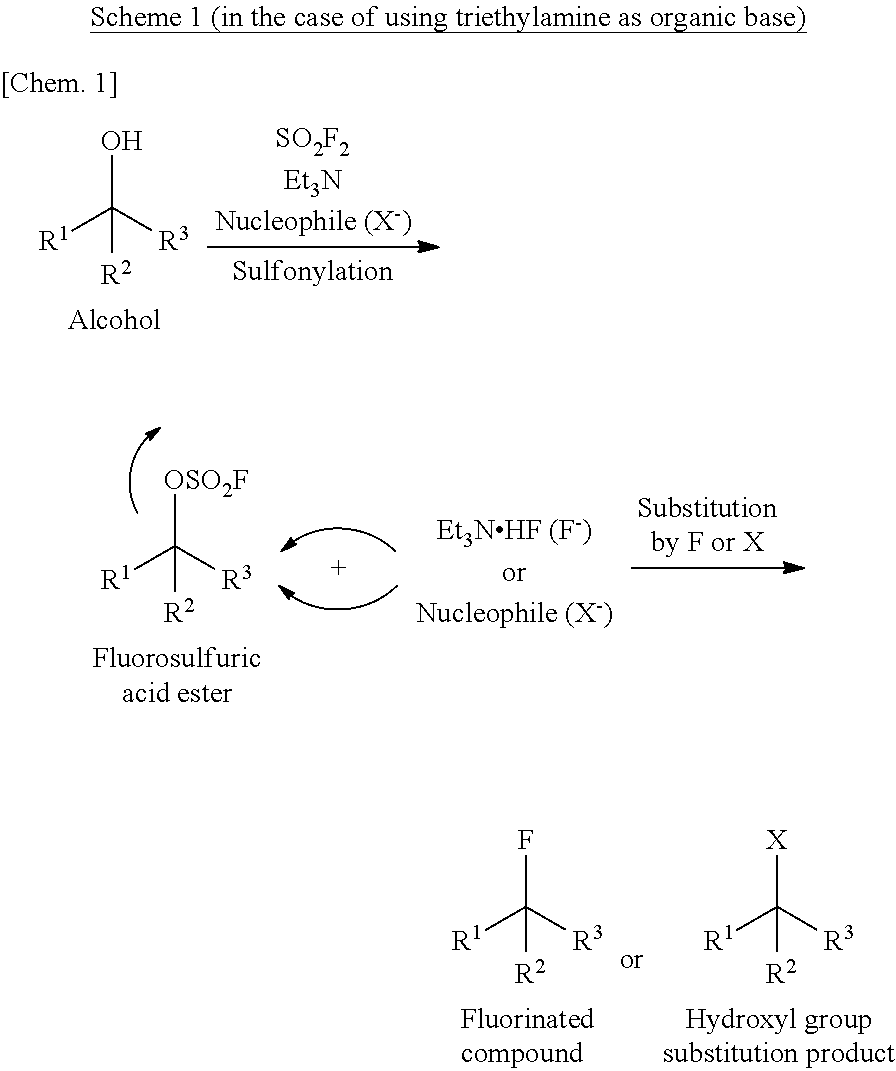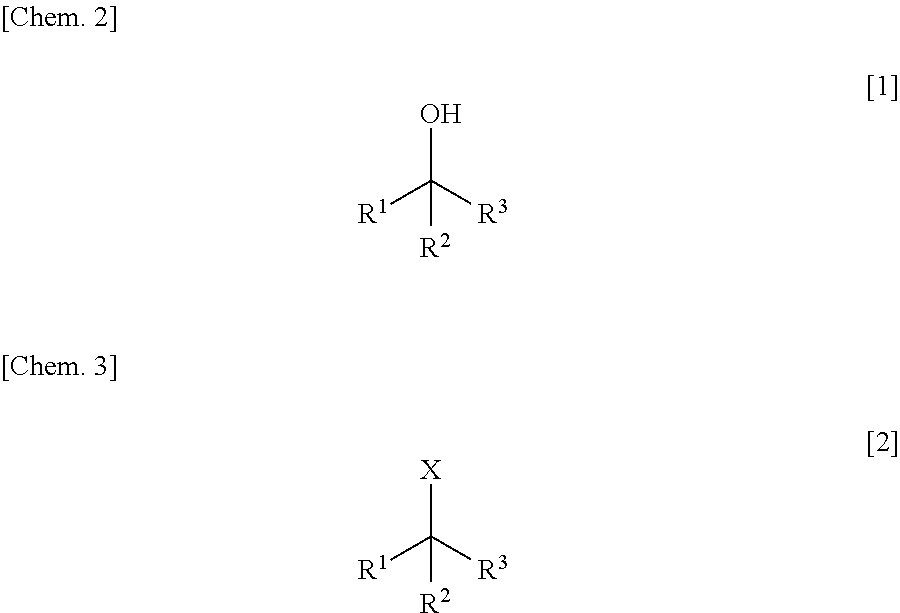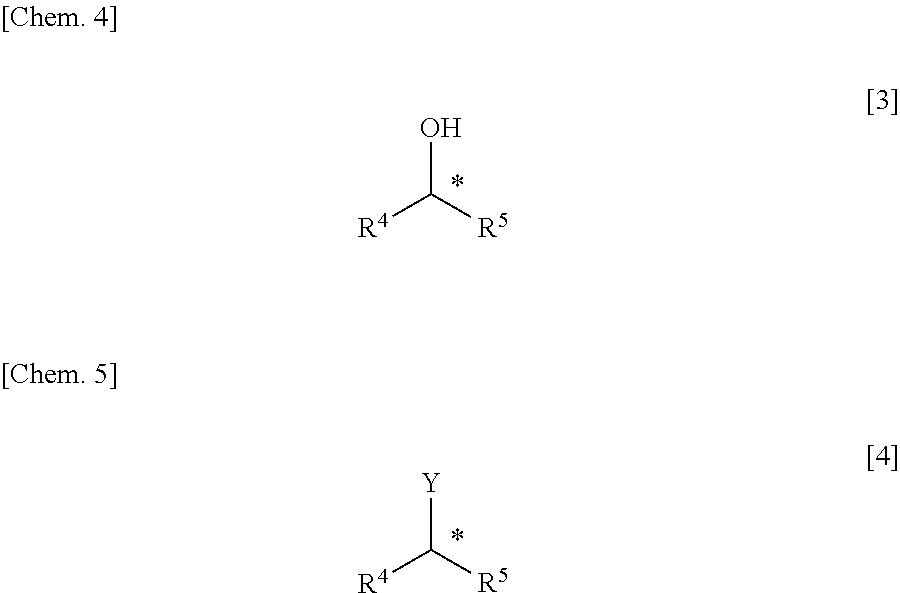Method for Manufacturing Hydroxyl Group Substitution Product
- Summary
- Abstract
- Description
- Claims
- Application Information
AI Technical Summary
Benefits of technology
Problems solved by technology
Method used
Image
Examples
example 1
[0069]Into a pressure-proof reaction vessel of stainless steel (SUS) were placed 4.73 g (40.0 mmol, 1.00 eq) of optically active α-hydroxyester of the following formula (S-configuration, 98% ee or higher):
40 mL (1.00 M) of acetonitrile, 4.65 g (36.0 mmol, 0.90 eq) of diisopropylethylamine and 11.6 g (36.0 mmol, 0.90 eq) of tetrabutylammonium bromide. Then, 8.16 g (80.0 mmol, 2.00 eq) of sulfuryl fluoride was blown from a cylinder into the reaction vessel under ice cooling conditions. The resulting reaction mixture solution was stirred for 2 hours and 50 minutes under ice cooling conditions. A part of the reaction mixture solution was diluted with ethyl acetate, washed with water, and then, analyzed by gas chromatography.
[0070]It was confirmed by the analytical results that: the conversion rate was 81%; the area percentage of optically active α-hydroxyl group substitution ester of the following formula (R-configuration):
was 73.8%; and the area percentage of fluorinated compound of th...
example 2
[0073]Into a pressure-proof reaction vessel of stainless steel (SUS) were placed 4.73 g (40.0 mmol, 1.00 eq) of optically active α-hydroxyester of the following formula (S-configuration, 98% ee or higher):
40 mL (1.00 M) of acetonitrile, 4.86 g (48.0 mmol, 1.20 eq) of triethylamine, 6.16 g (40.0 mmol, 1.00 eq) of tetramethylammonium bromide and 13.3 g (41.3 mmol, 1.03 eq) of tetrabutylammonium bromide. Then, 8.16 g (80.0 mmol, 2.00 eq) of sulfuryl fluoride was blown from a cylinder into the reaction vessel under ice cooling conditions. The resulting reaction mixture solution was stirred for 2 hours under ice cooling conditions. A part of the reaction mixture solution was diluted with ethyl acetate, passed through a short column of silica (for removal of origin component), and then, analyzed by gas chromatography.
[0074]It confirmed by the analytical results that: the conversion rate of the reaction was 100%; the area percentage of optically active α-hydroxyl group substitution ester o...
example 3
[0076]Into a pressure-proof reaction vessel of stainless steel (SUS) were placed 5.00 g (20.4 mmol, 1.00 eq) of optically active 4-hydroxyproline of the following formula (S-configuration at 2-position / R-configuration at 4-position, 98% ee or higher, 98% de or higher):
20 mL (1.02 M) of acetonitrile, 4.13 g (40.8 mmol, 2.00 eq) of triethylamine and 13.1 g (40.6 mmol, 1.99 eq) of tetrabutylammonium bromide. Then, 4.16 g (40.8 mmol, 2.00 eq) of sulfuryl fluoride was blown from a cylinder into the reaction vessel under ice cooling conditions. The resulting reaction mixture solution was stirred for 2 hours and 30 minutes under ice cooling conditions. It was confirmed by 1H-NMR analysis of the reaction mixture solution that the conversion rate of the reaction was 100%.
[0077]The thus-obtained reaction terminated liquid was concentrated under a reduced pressure to about one-third volume, diluted with 100 mL of toluene and washed six times with 50 mL of water. The organic layer was recovered...
PUM
 Login to View More
Login to View More Abstract
Description
Claims
Application Information
 Login to View More
Login to View More - R&D
- Intellectual Property
- Life Sciences
- Materials
- Tech Scout
- Unparalleled Data Quality
- Higher Quality Content
- 60% Fewer Hallucinations
Browse by: Latest US Patents, China's latest patents, Technical Efficacy Thesaurus, Application Domain, Technology Topic, Popular Technical Reports.
© 2025 PatSnap. All rights reserved.Legal|Privacy policy|Modern Slavery Act Transparency Statement|Sitemap|About US| Contact US: help@patsnap.com



